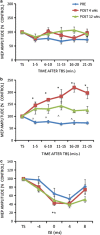Dopaminergic modulation of cortical plasticity in Alzheimer's disease patients
- PMID: 24859851
- PMCID: PMC4207345
- DOI: 10.1038/npp.2014.119
Dopaminergic modulation of cortical plasticity in Alzheimer's disease patients
Abstract
In animal models of Alzheimer's disease (AD), mechanisms of cortical plasticity such as long-term potentiation (LTP) and long-term depression (LTD) are impaired. In AD patients, LTP-like cortical plasticity is abolished, whereas LTD seems to be preserved. Dopaminergic transmission has been hypothesized as a new player in ruling mechanisms of cortical plasticity in AD. We aimed at investigating whether administration of the dopamine agonist rotigotine (RTG) could modulate cortical plasticity in AD patients, as measured by theta burst stimulation (TBS) protocols of repetitive transcranial stimulation applied over the primary motor cortex. Thirty mild AD patients were tested in three different groups before and after 4 weeks of treatment with RTG, rivastigmine (RVT), or placebo (PLC). Each patient was evaluated for plasticity induction of LTP/LTD-like effects using respectively intermittent TBS (iTBS) or continuous TBS protocols. Short-latency afferent inhibition (SAI) protocol was performed to indirectly assess central cholinergic activity. A group of age-matched healthy controls was recruited for baseline comparisons. Results showed that at baseline, AD patients were characterized by impaired LTP-like cortical plasticity, as assessed by iTBS. These reduced levels of LTP-like cortical plasticity were increased and normalized after RTG administration. No effect was induced by RVT or PLC on LTP. LTD-like cortical plasticity was not modulated in any condition. Cholinergic activity was increased by both RTG and RVT. Our findings reveal that dopamine agonists may restore the altered mechanisms of LTP-like cortical plasticity in AD patients, thus providing novel implications for therapies based on dopaminergic stimulation.
Figures





Similar articles
-
Impaired LTP- but not LTD-like cortical plasticity in Alzheimer's disease patients.J Alzheimers Dis. 2012;31(3):593-9. doi: 10.3233/JAD-2012-120532. J Alzheimers Dis. 2012. PMID: 22647254 Clinical Trial.
-
Long-term potentiation-like cortical plasticity is disrupted in Alzheimer's disease patients independently from age of onset.Ann Neurol. 2016 Aug;80(2):202-10. doi: 10.1002/ana.24695. Epub 2016 Jul 8. Ann Neurol. 2016. PMID: 27255833
-
Reversal of LTP-Like Cortical Plasticity in Alzheimer's Disease Patients with Tau-Related Faster Clinical Progression.J Alzheimers Dis. 2016;50(2):605-16. doi: 10.3233/JAD-150813. J Alzheimers Dis. 2016. PMID: 26757193
-
Mechanisms and applications of theta-burst rTMS on the human motor cortex.Brain Topogr. 2010 Jan;22(4):294-306. doi: 10.1007/s10548-009-0084-7. Epub 2009 Mar 14. Brain Topogr. 2010. PMID: 19288184 Review.
-
Do studies on cortical plasticity provide a rationale for using non-invasive brain stimulation as a treatment for Parkinson's disease patients?Front Neurol. 2013 Nov 6;4:180. doi: 10.3389/fneur.2013.00180. Front Neurol. 2013. PMID: 24223573 Free PMC article. Review.
Cited by
-
Drug repurposing for neurodegenerative diseases using Zebrafish behavioral profiles.Biomed Pharmacother. 2024 Feb;171:116096. doi: 10.1016/j.biopha.2023.116096. Epub 2024 Jan 6. Biomed Pharmacother. 2024. PMID: 38185043 Free PMC article.
-
Early Electrophysiological Disintegration of Hippocampal Neural Networks in a Novel Locus Coeruleus Tau-Seeding Mouse Model of Alzheimer's Disease.Neural Plast. 2019 Jun 12;2019:6981268. doi: 10.1155/2019/6981268. eCollection 2019. Neural Plast. 2019. PMID: 31285742 Free PMC article.
-
Hippocampal Neurogenesis Is Enhanced in Adult Tau Deficient Mice.Cells. 2020 Jan 14;9(1):210. doi: 10.3390/cells9010210. Cells. 2020. PMID: 31947657 Free PMC article.
-
Role of Stress-Related Dopamine Transmission in Building and Maintaining a Protective Cognitive Reserve.Brain Sci. 2022 Feb 11;12(2):246. doi: 10.3390/brainsci12020246. Brain Sci. 2022. PMID: 35204009 Free PMC article. Review.
-
Targeting neuroplasticity in patients with neurodegenerative diseases using brain stimulation techniques.Transl Neurodegener. 2020 Dec 7;9(1):44. doi: 10.1186/s40035-020-00224-z. Transl Neurodegener. 2020. PMID: 33280613 Free PMC article. Review.
References
-
- Appollonio I, Leone M, Isella V, Piamarta F, Consoli T, Villa ML, et al. The Frontal Assessment Battery (FAB): normative values in an Italian population sample. Neurol Sci. 2005;26:108–116. - PubMed
-
- Backman L, Nyberg L, Lindenberger U, Li SC, Farde L. The correlative triad among aging, dopamine, and cognition: current status and future prospects. Neurosci Biobehav Rev. 2006;30:791–807. - PubMed
-
- Baunez C, Robbins TW. Effects of dopamine depletion of the dorsal striatum and further interaction with subthalamic nucleus lesions in an attentional task in the rat. Neuroscience. 1999;92:1343–1356. - PubMed
-
- Boussaoud D, Kermadi I. The primate striatum: neuronal activity in relation to spatial attention versus motor preparation. Eur J Neurosci. 1997;9:2152–2168. - PubMed
Publication types
MeSH terms
Substances
LinkOut - more resources
Full Text Sources
Other Literature Sources
Medical
Molecular Biology Databases

